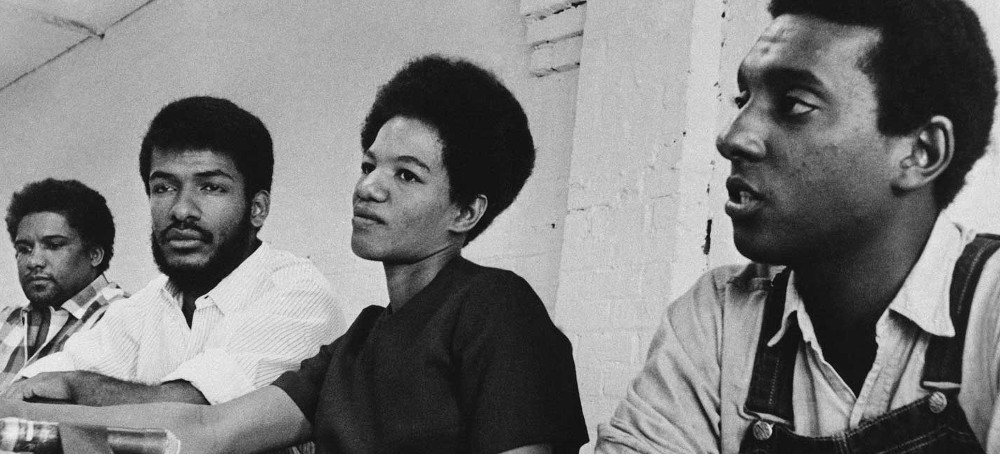On the History of the Black Power Movement in the USA
ANGLO AMERICA, 13 Feb 2023
Mark Whitaker | CBS News – TRANSCEND Media Service

Officers of the Student Non-Violent Coordinating Committee in Atlanta on May 23, 1966. From left to right: James Forman, Cleveland Sellers, Ruby Doris Smith Robinson and Stokely Carmichael. (photo: Horace Cort/AP)
5 Feb 2023 – It began on a hot summer night in Mississippi, with a cry from a young Black activist named Stokely Carmichael. The birth of Black Power in 1966 also saw the spread of Afros, dashikis, and the first celebration of Kwanzaa. Seen as radical then, its pioneers highlighted issues that are still very much with us today.
To secure voting rights in Alabama, Carmichael pushed Blacks to form their own political party with a striking panther logo. Borrowing that symbol in California, Huey Newton and Bobby Seale created an armed patrol to monitor police.
Yet for white North Americans, “Black Power” rang of menace. In polls, whites suddenly opposed even nonviolent Black protest by two to one. Rocks and racist taunts greeted Martin Luther King Jr. in Chicago.
Infighting also plagued the movement. At a chaotic retreat, Carmichael ousted John Lewis (the future Congressman) as leader of the Student Nonviolent Coordinating Committee, known as SNCC. SNCC militants pushed to expel all white members, leaving a trail of dried-up fundraising.
httpv://www.youtube.com/watch?v=lWuI9sU386g&t=19s
Asked to explain “Black Power,” Carmichael often provoked more than persuaded. In a 1966 primetime special, “Black Power – White Backlash,” he spoke with Mike Wallace of CBS News:
Wallace: “Mr. Carmichael, if you had the chance to stand up in front of the white community and say anything you desired, say to them, ‘Understand me, white man,’ what would you say?”
Carmichael: “I would say, ‘Understand yourself, white man. You are the savages. Yes, it is you who have always been uncivilized. Civilize yourself.'”
For today’s #BlackLivesMatter Movement, the tumultuous history of Black Power offers lessons, and warnings, about the importance of messaging, unity, and cross-racial alliances.
Yet beyond politics, Black Power had a deep personal meaning. In 1966, veteran journalist Vern Smith was a student at San Francisco State University, where the push for Black Studies began. For him and his Black friends, Vern said, “It was almost like a born-again experience. We were no longer Negroes.”
And those African dashikis that remain a symbol of proud Black identity? Well, Vern admits, “we didn’t even know what dashikis were before then.”
READ AN EXCERPT: “Saying It Loud: 1966—The Year Black Power Challenged the Civil Rights Movement” by Mark Whitaker
For more info:
- “Saying It Loud: 1966—The Year Black Power Challenged the Civil Rights Movement” by Mark Whitaker (Simon & Schuster), in Hardcover, eBook and Audio formats, available February 7 via Amazon, Barnes & Noble and Indiebound
Tags: Activism, Anglo America, Black America, Black Culture, Black Lives Matter, Black Panther Party, Civil Rights, History, Racism, USA
DISCLAIMER: The statements, views and opinions expressed in pieces republished here are solely those of the authors and do not necessarily represent those of TMS. In accordance with title 17 U.S.C. section 107, this material is distributed without profit to those who have expressed a prior interest in receiving the included information for research and educational purposes. TMS has no affiliation whatsoever with the originator of this article nor is TMS endorsed or sponsored by the originator. “GO TO ORIGINAL” links are provided as a convenience to our readers and allow for verification of authenticity. However, as originating pages are often updated by their originating host sites, the versions posted may not match the versions our readers view when clicking the “GO TO ORIGINAL” links. This site contains copyrighted material the use of which has not always been specifically authorized by the copyright owner. We are making such material available in our efforts to advance understanding of environmental, political, human rights, economic, democracy, scientific, and social justice issues, etc. We believe this constitutes a ‘fair use’ of any such copyrighted material as provided for in section 107 of the US Copyright Law. In accordance with Title 17 U.S.C. Section 107, the material on this site is distributed without profit to those who have expressed a prior interest in receiving the included information for research and educational purposes. For more information go to: http://www.law.cornell.edu/uscode/17/107.shtml. If you wish to use copyrighted material from this site for purposes of your own that go beyond ‘fair use’, you must obtain permission from the copyright owner.